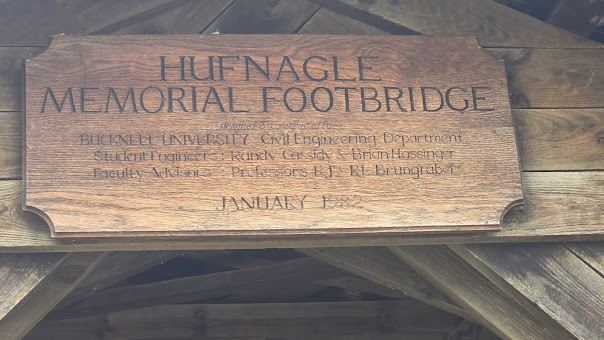The Gordon A Hufnagle Memorial bridge is an single span built by two Bucknell University Students, in memory of a local hero who lost his life while attempting the rescue of Lewisburg citizens during the 1972 flood.
Gordon Hufnagle was Lewisburg's chief of police from 1942 to 1970, and then he was promoted to borough safety officer. On June 22, 1972 the rescue boat he was piloting capsized in the flood waters.
Hufnagle Park in Lewisburg is named for him, and there is a stone with a plaque on it in the park.
Lewisburg Mayor Lewis Hendricks proposed the idea of a bridge in honor of Hufnagle, to cross Bull Run creek for pedestrian traffic. Bucknell engineering students Brian Hassinger, and Randy Cassidy, both needing a project for their civil engineering design class, offered to take on the project.
Hassinger was quoted as saying: "A lot of senior projects are just blueprints and calculations. We decided to do a full scale project."
Money for the bridges construction came from the Hufnagle Memorial Fund. The estimated cost was $35,000, but with massive support from local businesses, the total cost to the Hufnagle fund was around $5,000.
The bridge, in a "town lattice" design, is a 46 foot single span covered bridge. The design was patterned after the "first American Covered Bridge by Ithiel Town" - consisting of overlapping beams that resemble a cross crossed garden fence.
Although the first documented covered bridge in the US was erected in Philadelphia c. 1805, the Ithiel Town Lattice Truss bridge design is patented in 1820 in the United States, is often referred to as "the first truly American Covered Bridge."
The roof of the bridge was covered in hand split cedar shingles. A local furniture builder produced 1,100 trunnels [wooden pegs] used to fasten the beams together.
The span was also designed to "swing away from it's moorings and float parallel to the stream when the creek is high so as not to obstruct water flow." Steel cables would hold the bridge parallel to the stream of water.
The students constructed it in a one and a half story corrugated steel building, and they had to tear a wall down to move the bridge out.
It took about four hours to complete the move and get the bridge in place.
Don Moyer's Crane Service helped to move the bridge, and place it in it's new location, on Saturday January 16th 1982.
The bridge was scheduled to leave the west area of Bucknell at 10am, proceed east on Moore Avenue, Loomis, and Walker Streets, north on University Avenue, and South Third Street, then west on Market.
"The footbridge, with its unique 'swing away' design for safety, was to be the focal point of Hufnagle park.
The dedication ceremony, sponsored by the Lewisburg police department, was held at 2:30pm, and reportedly, shingles were still being nailed on the bridge right up until the ribbon was cut.
More than 100 attended the dedication that day. The ribbon was cut by Blanche and Florence Hufnagle, widow and mother of Gordon.

After the ribbon was cut, and christened with a bottle of champagne, wooden pegs like the ones used to hold the bridge together were distributed as souvenirs. Hendricks and Cassidy autographed many of the pegs.

The Daily Item reported:
"The recreational area at North Sixth and Market Streets was dedicated to Hufnagle's Memory about a year ago. The footbridge was placed over Bull Run in the park just before the start of Saturday's ceremony"

On September 3rd 1996, a film crew from the Japanese show Bridges Of the World filmed the bridge for a 4 minute segment on their prime time show, which was originally inspired by The Bridges of Madison County.
=================
READ MORE
==================
READ MORE
==================
Read more about Hufnagle here:






.jpg)





No comments:
Post a Comment
I'll read the comments and approve them to post as soon as I can! Thanks for stopping by!